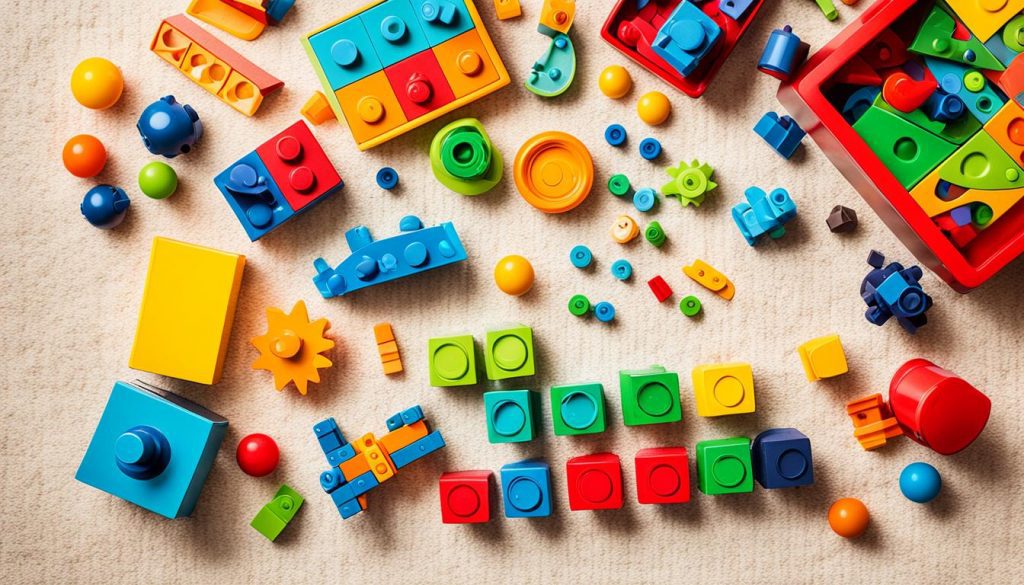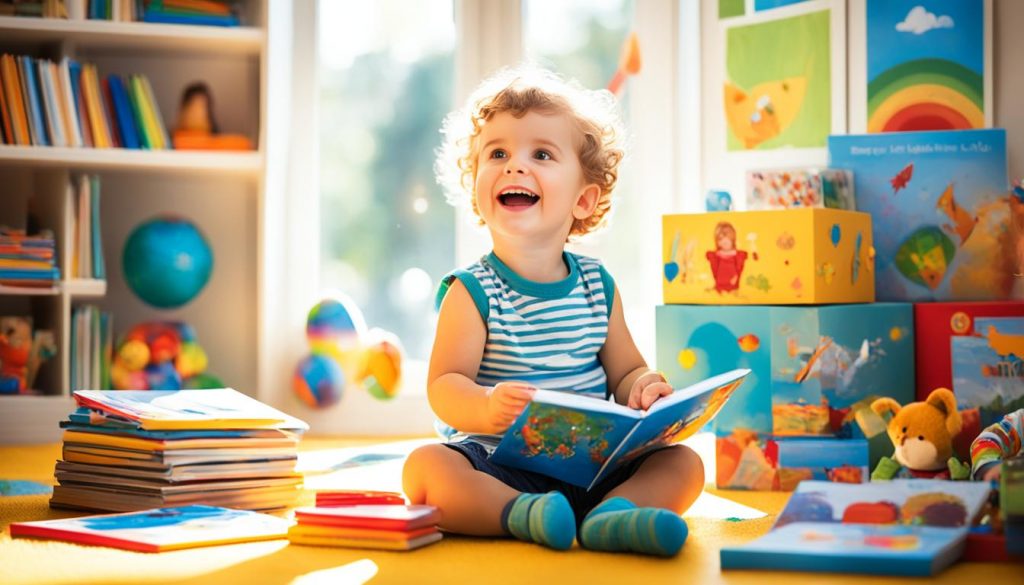Welcome to our blog, where we explore the joys of fostering a love for learning in early childhood. At this critical stage of development, children’s brains are like sponges, absorbing knowledge and forming the building blocks for future academic success. By nurturing their natural curiosity, providing stimulating environments, and engaging them in age-appropriate activities, we can ignite a lifelong passion for education.
In this section, we will delve into the importance of early childhood education and discover effective strategies to foster a love of learning in young children. From reading and asking questions to encouraging creativity and applying academic readiness skills, there are countless ways to make learning enjoyable, relevant, and engaging.
Key Takeaways:
- Early childhood education is crucial for setting the stage for future academic success.
- Providing choices, plenty of books, and encouraging questioning helps foster a love for learning.
- Allowing for creativity and making learning fun and relevant are important strategies.
- Parents play a crucial role as their child’s first and best teacher in fostering a love of learning.
- Teachers also play a vital role in creating a supportive and engaging learning environment.
The Importance of Early Childhood Education
Early childhood education plays a pivotal role in shaping a child’s future academic success. During these crucial years, children’s brains develop rapidly, forming essential neural connections that lay the foundation for their learning journey. It is through play-based and age-appropriate learning that young children thrive, as they engage in hands-on activities, explore their surroundings, and observe the world around them.
While formal early childhood education programs are important, parents are their child’s first and best teacher. They have a unique opportunity to provide educational resources, create effective learning strategies, and cultivate a love for learning that lasts a lifetime.
The Power of Play-Based Learning
Play is not just a source of entertainment for children; it is a vital component of their development. Engaging in play allows children to naturally explore, experiment, and make sense of the world. Through play, they develop cognitive, social, emotional, and physical skills that form the building blocks of their learning journey.
By providing educational resources that foster imagination and creativity, parents can harness the power of play to promote effective learning. This can include age-appropriate toys, books, puzzles, and interactive games that encourage problem-solving, critical thinking, and communication skills.
The Role of Parents as Educators
Parents have a significant impact on their child’s learning journey. By creating a supportive and nurturing environment at home, parents can stimulate their child’s curiosity and create a love for learning. This can be achieved by incorporating educational activities into daily routines, such as reading together, engaging in conversations, and providing hands-on learning experiences.
Furthermore, parents can leverage technology to access educational resources that supplement their child’s learning. Online platforms, interactive apps, and educational websites offer a wealth of resources tailored to different age groups, helping parents provide a well-rounded and comprehensive learning experience for their children.
Collaboration between Parents and Early Childhood Educators
While parents play a crucial role in their child’s education, collaboration with early childhood educators is essential for ensuring a holistic learning experience. By maintaining open lines of communication, parents can gain insights into their child’s progress, receive guidance on effective learning strategies, and develop a stronger partnership in nurturing the child’s growth.
Together, parents and early childhood educators can create an environment where children feel supported, encouraged, and empowered to explore their interests and develop a lifelong passion for education.
Strategies for Fostering a Love of Learning
When it comes to fostering a love of learning in young children, there are several effective strategies that can promote their academic success and overall growth. By incorporating these strategies into their daily routines, parents and educators can provide valuable learning experiences that nurture a lifelong passion for education.
1. Reading
Reading to children is one of the most powerful learning tools for kids. It not only enhances language development and early literacy skills but also stimulates curiosity and imagination. By creating a reading routine and exploring a wide range of books, parents and educators can ignite a love for learning and open up a world full of knowledge and possibilities.
2. Asking Questions
Encouraging children to ask questions fosters critical thinking and reasoning skills. It promotes curiosity and allows children to explore their interests while developing a deeper understanding of the world around them. By creating a safe and supportive environment where questions are welcomed and encouraged, parents and educators can spark intellectual curiosity and promote active learning.
3. Changing the Way You Praise Them
The way we praise children can significantly impact their mindset and attitude towards learning. Instead of solely praising the end result, such as getting a correct answer or completing a task, focus on praising their effort, process, and strategy. This builds confidence in the learning process itself, encouraging children to persevere, take risks, and embrace challenges as opportunities for growth.
4. Encouraging Mistakes
Mistakes are an integral part of the learning journey. Encouraging children to view mistakes as valuable learning opportunities promotes a growth mindset and resilience. By creating a supportive environment where mistakes are seen as stepping stones to success, parents and educators empower children to take risks, develop problem-solving skills, and embrace the learning process without fear of failure.
5. Allowing Creativity
Creativity is essential for fostering critical thinking, problem-solving, and innovation. By providing children with opportunities to explore their imagination, express their thoughts and ideas, and engage in creative activities, parents and educators enable them to think outside the box and approach learning in unique and meaningful ways.
6. Applying Academic Readiness Skills to the Outside World
Learning becomes more engaging and applicable when children can see how academic readiness skills relate to real-life situations. By connecting what they are learning to everyday experiences, parents and educators help children understand the practical applications of their knowledge and develop a deeper appreciation for the value of education.


Implementing these strategies not only promotes a love of learning but also empowers children to become confident, self-directed learners. By creating a nurturing and supportive learning environment, parents and educators play a pivotal role in promoting academic success and instilling a lifelong passion for education.
Understanding Early Childhood Development
During the early years of life, a child’s brain undergoes rapid development, forming essential neural connections that lay the foundation for future learning and growth. The child’s natural curiosity and exploration play a crucial role in this development, making it imperative to provide a supportive environment that fosters these innate tendencies.
Play-based learning and hands-on experiences are particularly beneficial for young children’s cognitive and social-emotional development. By engaging in activities that stimulate their curiosity and encourage exploration, children can actively build new connections in their brain, expanding their knowledge and understanding of the world around them.
Creating a supportive environment involves providing opportunities for children to explore, experiment, and discover at their own pace. By offering age-appropriate materials, open-ended toys, and safe spaces for exploration, we can nurture their natural inclination towards learning and encourage their independence.
Furthermore, incorporating play-based learning into daily routines enables children to develop essential skills such as problem-solving, critical thinking, and self-regulation. Through play, children can explore their interests, experiment with different ideas, and learn from both successes and failures.
A supportive environment also involves providing positive reinforcement, encouragement, and support. By recognizing and celebrating children’s achievements, we can boost their self-confidence and motivation to continue learning. Furthermore, offering gentle guidance and support when children face challenges helps them develop resilience and persistence in their learning journey.
Recognizing Children’s Learning Styles
Recognizing a child’s learning style is essential in maximizing their educational experience. By understanding how children perceive and engage with information, we can tailor their learning methods to suit their unique strengths. In this section, we will explore three primary learning styles: visual learners, auditory learners, and kinesthetic learners.
Visual Learners
Visual learners absorb information best through visual aids, charts, and diagrams. They have a keen sense of observation and can easily remember and recall information that they have seen. To cater to visual learners, incorporating visual elements into their learning environment is crucial. This can be achieved by providing visual representations of concepts, such as diagrams or infographics, and utilizing colorful materials to capture their attention. Visual learners benefit from visual aids that help them organize and understand information more effectively.
Auditory Learners
Auditory learners, on the other hand, learn best through listening and benefit from verbal instructions and discussions. They retain information by hearing and speaking, making auditory learning methods highly effective for them. To support auditory learners, it is important to provide opportunities for discussions, group activities, and storytelling. Verbal repetition, reading aloud, and utilizing audio resources can also enhance their learning experience. Engaging auditory learners through meaningful conversations and audio-based learning materials can help them grasp concepts more proficiently.
Kinesthetic Learners
Kinesthetic learners thrive in hands-on activities and learn by doing. They’re highly active and enjoy physical movement in their learning process. Kinesthetic learners may struggle with traditional classroom settings that limit physical engagement. Therefore, incorporating hands-on activities, manipulatives, and interactive learning experiences is crucial to cater to their learning style. These learners benefit from engaging in experiments, role-playing, and other forms of physical exploration to deepen their understanding.
Recognizing and accommodating a child’s learning style can make a significant difference in their educational journey. By adapting teaching methods to align with their strengths, we can empower children to engage more actively with the learning process and achieve greater academic success.
The Role of Parents and Teachers in Fostering Child Learning
Parents play a crucial role in nurturing a love for learning in their children. By setting a positive example, creating a supportive environment, and encouraging their child’s interests, parents can instill confidence and ignite a thirst for knowledge in their little learners.
- Setting a positive example: Parents who value education and demonstrate a love for learning themselves inspire their children to do the same. By engaging in lifelong learning and sharing their passions, parents create an environment where education is celebrated and valued.
- Building a supportive environment: Creating a positive and conducive learning environment is essential for a child’s educational journey. Parents can set aside a designated study area, provide access to educational resources, and establish consistent routines that prioritize learning.
- Encouraging child’s interests: Recognizing and supporting a child’s interests and strengths is paramount. Offering opportunities for exploration and providing educational materials tailored to their interests can foster a genuine love for learning and help children excel in areas they are passionate about.
Teachers also play a vital role in fostering child learning. In collaboration with parents, they can create a cohesive learning community that nurtures the growth and development of every child.
- Creating a supportive learning environment: Teachers can establish a safe and inclusive classroom where students feel valued and encouraged to take risks. By creating a positive and respectful atmosphere, teachers foster an environment where students feel comfortable asking questions and actively engaging in the learning process.
- Individualizing instruction: Recognizing that each child is unique, teachers can tailor their teaching methods to accommodate different learning styles and abilities. By providing differentiated instruction and personalized learning experiences, teachers can ensure that every student has the opportunity to thrive.
- Collaborating with parents: Regular communication and collaboration with parents are essential for a child’s educational journey. By exchanging insights, sharing progress, and working together to support the child’s learning and development, parents and teachers can provide a seamless learning experience that extends beyond the classroom.
By understanding and embracing their crucial roles in fostering child learning, parents and teachers can create a powerful partnership that nurtures a lifelong love for education.
| Parents | Teachers | |
|---|---|---|
| Role | Nurturing a love for learning | Fostering a supportive learning environment |
| Responsibilities |
|
|
| Impact | Nurturing confidence and a thirst for knowledge | Nurturing a love for learning and student growth |
Conclusion
Fostering a love for learning in young children is a continuous process that requires a nurturing environment, play-based learning, and a supportive community. As parents, we have the incredible opportunity to become our children’s first and best teachers, instilling confidence and nurturing a lifelong passion for education. By incorporating various strategies into our daily interactions with our children, we can create an optimal learning environment that promotes their love for learning.
One of the most effective strategies is reading to our children. Through shared storytime, we can enhance their language development, early literacy skills, and curiosity. Encouraging questioning and critical thinking also plays a vital role in fostering child learning. By asking open-ended questions, we encourage our children to think deeper and develop their reasoning skills.
It is essential to celebrate effort and growth rather than focusing solely on outcomes. By praising their effort and strategy, we teach them that learning is a process that takes time and perseverance. We should also encourage them to embrace mistakes as valuable learning opportunities, making them understand that making errors is part of the learning journey. Allowing our children to explore their creativity through various activities, such as art, music, or imaginative play, foster critical thinking and problem-solving skills.
Finally, we can make learning more meaningful and engaging for our children by applying academic readiness skills to real-life situations. This helps them see the relevance of what they are learning and connects their education to their everyday experiences. By embracing these strategies, we can create a positive and stimulating learning environment that nurtures our children’s love for learning and sets them on a path towards a lifelong passion for education.
FAQ
How does early childhood education impact future academic success?
Early childhood education has a profound impact on a child’s future academic success. It is during these years that children’s brains are rapidly developing, forming essential neural connections. Play-based, age-appropriate learning is the most effective for young children, as they learn through doing, discovering, exploring, and observing.
What are some strategies for fostering a love of learning in young children?
Strategies for fostering a love of learning in young children include reading, asking a lot of questions, changing the way you praise them, encouraging mistakes, allowing creativity, and applying academic readiness skills to the outside world. Reading to children enhances language development, early literacy skills, and curiosity. Asking questions promotes critical thinking and reasoning skills. Changing the way you praise them by focusing on effort, process, and strategy builds confidence in the learning process. Encouraging mistakes helps children understand that learning takes time and effort. Allowing creativity fosters critical thinking and problem-solving. Applying academic readiness skills to real-life situations makes learning more applicable and engaging for children.
How does a child’s brain develop during the early years of life?
During the early years of life, a child’s brain is rapidly developing, forming essential neural connections. Curiosity and exploration are natural drivers of this development, making it crucial to provide a supportive environment that encourages these innate tendencies. Play-based learning and hands-on experiences are especially beneficial for young children’s cognitive and social-emotional development.
How can parents and teachers support a child’s learning journey?
Parents play a crucial role in fostering a love for learning in their children. By setting an example, building a positive learning environment, and encouraging their child’s interests, parents can instill confidence and a thirst for knowledge in their little learners. Teachers also play a vital role in providing a supportive and engaging learning environment for children, collaborating with parents to create a cohesive learning community.



